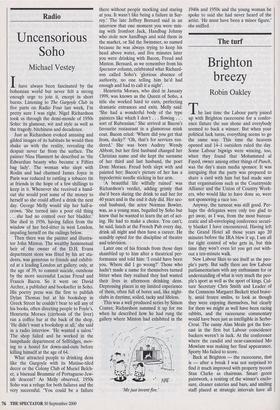Radio
Uncensorious Soho
Michael Vestey
Ihave always been fascinated by the bohemian world but never felt a strong enough urge to join it, except in short bursts. Listening to The Gargoyle Club in five parts on Radio Four last week, I'm pretty sure I was right. Nigel Richardson took us through the demi-monde of 1950s Soho: its glamour, wit and style as well as the tragedy, bitchiness and decadence.
Just as Richardson evoked amusing and gilded images of its habitués he would then shake us with the reality, revealing the despair never far from the surface. The painter Nina Hamnett he described as 'the Edwardian beauty who became a Fifties bag lady'. The woman who slept with Rodin and had charmed James Joyce in Paris was reduced to rattling a tobacco tin at friends in the hope of a few shillings to keep in it. Whenever she received a hand- out she would post some of the money to herself so she could afford a drink the next day. George Melly would slip her half-a- crown. 'She turned into a poor old thing ... she had no control over her bladder.' She died in 1956, having fallen from the window of her bed-sitter in west London, impaling herself on the railings below.
Then there was the painter and illustra- tor John Minton. The wealthy homosexual heir of the owner of the D.H. Evans department store was feted by his art stu- dents, was generous to friends and exhibit- ed at a leading London art gallery; only, at the age of 39, to commit suicide, outshone by the more successful Lucian Freud and Francis Bacon. So it went on: David Archer, a publisher and bookseller in Soho. His poetry press was the first to publish Dylan Thomas but at his bookshop in Greek Street he couldn't bear to sell any of his books, often directing people to Foyle's. Henrietta Moraes (cirrhosis of the liver) ran a coffee bar at the back of the shop. `He didn't want a bookshop at all,' she said in a radio interview. 'He wanted a salon.' The shop failed and he worked in the lampshade department of Selfridges, mov- ing to a hostel for down-and-outs before killing himself at the age of 64.
What attracted people to drinking dens like the Gargoyle with its Matisse-tiled decor or the Colony Club of Muriel Belch- er, a bisexual Brummie of Portuguese-Jew- ish descent? As Melly observed, 1950s Soho was a refuge for both failures and the very successful. 'You could be a failure there without people mocking and staring at you. It wasn't like being a failure in Sur- rey.' The late Jeffrey Bernard said in an interview that one moment you were mix- ing with Ironfoot Jack, Handbag Johnny who stole new handbags and sold them in the market, or Sid the Swimmer, so named because he was always trying to keep his head above water, and five minutes later you were drinking with Bacon, Freud and Minton. Bernard, as we remember from his Spectator column, celebrated what Richard- son called Soho's 'glorious absence of authority, no one telling him he'd had enough and had to call it a night'.
Henrietta Moraes, who died in January 1999, was known as the Queen of Soho, a title she worked hard to earn, perfecting dramatic entrances and exits. Melly said: `She had a wonderful body of the type painters like which I don't . . . flowing . . sort of Rubensian.' She arrived at Bacon's favourite restaurant in a glamorous mink coat. Bacon cried: 'Where did you get that from, ducky?"0h, that's for services ren- dered.' She was born Audrey Wendy Abbott, but her first husband changed her Christian name and she kept the surname of her third and last husband, the poet Dom Moraes. Freud both slept with and painted her; Bacon's picture of her has a hypodermic needle sticking in her arm.
`A beautiful life wilfully ruined' was Richardson's verdict, adding grimly that she'd been daring the drink to nail her for 40 years and in the end it duly did. Her sec- ond husband, the actor Norman Bowler, was, as a young man, beguiled by Soho but knew that he wanted to learn the art of act- ing. He had to make a choice. You can't, he said, lunch at the French Pub every day, drink all night and then have a career. He sensibly opted for the discipline of theatre and television.
Later one of his friends from those days shambled up to him after a theatrical per- formance and told him: 'I could have been you. Where did I go wrong?' Those who hadn't made a name for themselves turned bitter when they realised they had wasted their lives in afternoon drinking dens. Depressing places in my limited experience of them, often full of bores and, like night- clubs in daytime, soiled, tacky and lifeless.
This was a well produced series by Simon Coates; Richardson summed it up for me when he described how he had rung the gallery where Minton had exhibited in the Me just invent fire.' 1940s and 1950s and the young woman he spoke to said she had never heard of the artist. 'He must have been a minor figure,' she sniffed.


























































































 Previous page
Previous page